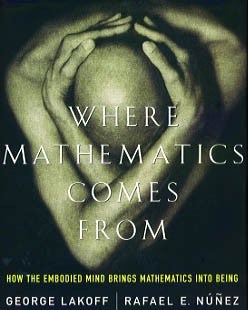
A metaphor is a figure of speech that, for rhetorical effect, directly refers to one thing by mentioning another. It may provide clarity or identify hidden similarities between two different ideas.

Where Mathematics Comes From: How the Embodied Mind Brings Mathematics into Being is a book by George Lakoff, a cognitive linguist, and Rafael E. Núñez, a psychologist. Published in 2000, WMCF seeks to found a cognitive science of mathematics, a theory of embodied mathematics based on conceptual metaphor.
In cognitive linguistics, conceptual metaphor, or cognitive metaphor, refers to the understanding of one idea, or conceptual domain, in terms of another. An example of this is the understanding of quantity in terms of directionality or the understanding of time in terms of money.

Comics is a medium used to express ideas with images, often combined with text or other visual information. It typically takes the form of a sequence of panels of images. Textual devices such as speech balloons, captions, and onomatopoeia can indicate dialogue, narration, sound effects, or other information. There is no consensus among theorists and historians on a definition of comics; some emphasize the combination of images and text, some sequentiality or other image relations, and others historical aspects such as mass reproduction or the use of recurring characters. Cartooning and other forms of illustration are the most common image-making means in comics; fumetti is a form that uses photographic images. Common forms include comic strips, editorial and gag cartoons, and comic books. Since the late 20th century, bound volumes such as graphic novels, comic albums, and tankōbon have become increasingly common, along with webcomics.
Organizational culture refers to culture related to organizations including schools, universities, not-for-profit groups, government agencies, and business entities. Alternative terms include corporate culture and company culture. The term corporate culture emerged in the late 1980s and early 1990s. It was used by managers, sociologists, and organizational theorists in the 1980s.

In anthropology, kinship is the web of social relationships that form an important part of the lives of all humans in all societies, although its exact meanings even within this discipline are often debated. Anthropologist Robin Fox says that the study of kinship is the study of what humans do with these basic facts of life – mating, gestation, parenthood, socialization, siblingship etc. Human society is unique, he argues, in that we are "working with the same raw material as exists in the animal world, but [we] can conceptualize and categorize it to serve social ends." These social ends include the socialization of children and the formation of basic economic, political and religious groups.
Organizational behavior or organisational behaviour is the: "study of human behavior in organizational settings, the interface between human behavior and the organization, and the organization itself". Organizational behavioral research can be categorized in at least three ways:
Visual culture is the aspect of culture expressed in visual images. Many academic fields study this subject, including cultural studies, art history, critical theory, philosophy, media studies, Deaf Studies, and anthropology.
Mass communication is the process of imparting and exchanging information through mass media to large population segments. It utilizes various forms of media as technology has made the dissemination of information more efficient. Primary examples of platforms utilized and examined include journalism and advertising. Mass communication, unlike interpersonal communication and organizational communication, focuses on particular resources transmitting information to numerous receivers. The study of mass communication is chiefly concerned with how the content and information that is being mass communicated persuades or affects the behavior, attitude, opinion, or emotion of people receiving the information.
Relational frame theory (RFT) is a psychological theory of human language, cognition, and behaviour. It was developed originally by Steven C. Hayes of University of Nevada, Reno and has been extended in research, notably by Dermot Barnes-Holmes and colleagues of Ghent University.
Men's studies is an interdisciplinary academic field devoted to topics concerning men, masculinity, gender, culture, politics and sexuality. It academically examines what it means to be a man in contemporary society.
Susan Bordo is an American philosopher known for her contributions in the field of contemporary cultural studies, particularly in the area of feminist theory. Bordo specializes in contemporary culture and its relation to the body, focusing on eating disorders which primarily affect females, such as anorexia and bulimia; cosmetic surgery; beauty; and evolutionary theory. She also explores racism and the body, masculinity, and sexual harassment.

Theory of International Politics is a 1979 book on international relations theory by Kenneth Waltz that creates a structural realist theory, neorealism, to explain international relations. Taking into account the influence of neoclassical economic theory, Waltz argued that the fundamental "ordering principle" (p. 88) of the international political system is anarchy, which is defined by the presence of "functionally undifferentiated" (p. 97) individual state actors lacking "relations of super- and subordination" (p. 88) that are distinguished only by their varying capabilities.
Cultural materialism is an anthropological research orientation first introduced by Marvin Harris in his 1968 book The Rise of Anthropological Theory, as a theoretical paradigm and research strategy. It is said to be the most enduring achievement of that work. Harris subsequently developed a full elaboration and defense of the paradigm in his 1979 book Cultural Materialism. To Harris social change is dependent of three factors: a society's infrastructure, structure, and superstructure.

The sociology of space is a sub-discipline of sociology that mostly borrows from theories developed within the discipline of geography, including the sub fields of human geography, economic geography, and feminist geography. The "sociology" of space examines the social and material constitution of spaces. It is concerned with understanding the social practices, institutional forces, and material complexity of how humans and spaces interact. The sociology of space is an inter-disciplinary area of study, drawing on various theoretical traditions including Marxism, postcolonialism, and Science and Technology Studies, and overlaps and encompasses theorists with various academic disciplines such as geography and architecture. Edward T. Hall developed the study of Proxemics which concentrates on the empirical analysis of space in psychology.
Martha Finnemore is an American constructivist scholar of international relations, and University Professor at the Elliott School of International Affairs at George Washington University. She is considered among the most influential international relations scholars. Her scholarship has highlighted the role of norms and culture in international politics, as well as shown that international organizations are consequential and purposive social agents in world politics that can shape state interests.
Gareth Morgan is a British/Canadian organizational theorist, management consultant and Distinguished Research Professor at York University in Toronto. He is known as creator of the "organisational metaphor" concept and writer of the 1979 book Sociological Paradigms and Organizational Analysis with Gibson Burrell and the 1986 best-seller Images of Organization.
Corporate DNA refers, in business jargon, to organizational culture. It is a metaphor based on the biological term DNA, the molecule that encodes the genetic instructions in living organisms.
David Morgan is Professor of Religious Studies at Duke University, in Durham, North Carolina, with an additional appointment in Duke's Department of Art, Art History and Visual Studies. Morgan served as the Chair in the Department of Religious Studies in Trinity College of Duke University from 2013 to 2016. He is the author of numerous books, including The Forge of Vision (2015), The Embodied Eye (2012), and The Sacred Gaze (2005).
Cultural evolution is an evolutionary theory of social change. It follows from the definition of culture as "information capable of affecting individuals' behavior that they acquire from other members of their species through teaching, imitation and other forms of social transmission". Cultural evolution is the change of this information over time.






